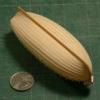-
Posts
13,170 -
Joined
-
Last visited
Content Type
Profiles
Forums
Gallery
Events
Everything posted by druxey
-
It's a very clever idea. (Nice looking model, too!) That looks quite convincing: I assume this is at 1:48 scale?
-
Thank you, Team Notebook!
- 19 replies
-
- Early Navy
- frigates
-
(and 2 more)
Tagged with:
-
I'm sure that there were a lot of transitional rigs. You are safe there!
-
Heh, heh. And tomorrow, the world! Actually, I'd need to learn a suitable CAD program first before scorching any wood. Sorry about your scroll saw, E&T. I hope you got good mileage out of it before it quit.
- 346 replies
-
- terror
- polar exploration
-
(and 2 more)
Tagged with:
-

First time rigging - being organized
druxey replied to RichardG's topic in Masting, rigging and sails
Before one has rigged a model, the task seems utterly daunting. This is Stage 1, where you are at. Take a deep breath and get yourself centered. Rigging is essentially a logical exercise. This should, as a software engineer, reassure you. Every line has a purpose and function, even if this is not immediately apparent. Begin with the standing rigging, lower first, working from forward to aft. If in doubt, there is plenty of help available on this forum. We all began our rigging experience at Stage 1 (see above). -

Possible new technique for making sails.
druxey replied to rckdr's topic in Masting, rigging and sails
There is a new technique for making sails described in the revised TFFM, Volume IV. (The relevant information is also available as a separate booklet form SeaWatch Books.) The results can be seen on the 'workshops' page of Admiralty Models. You can see for yourself how this looks. -
The mizzen topgallant mast and yard was not usually fitted to smaller rates until the 1790's. This was also apparently true of driver booms. The updated masting plan indicates this.
-
Nice use of the free library technology! Where do you live? I'll be right over! Everything on the hull lines up beautifully.
- 346 replies
-
- terror
- polar exploration
-
(and 2 more)
Tagged with:
-
I like this story, Wefalck! Looking forward to the next instalment....
-
Acrylic/latex caulking is good as it will take paint, whereas silicon will not. As it is not really sandable when dry, you will need to apply it carefully and wipe it with a damp piece of paper towel to smooth it.
- 253 replies
-
- ketkch
- gaff-rigged
-
(and 1 more)
Tagged with:
-
Yup, primer will show up everything! Fortunately, in this case a bit of automotive filler and sanding will see you right. I'd use caulking at the plank/stem joint, though.
- 253 replies
-
- ketkch
- gaff-rigged
-
(and 1 more)
Tagged with:
-
You haven't been idle, have you, Mobbsie? The new suit of sails looks terrific.
- 62 replies
-
- harwich bawley
- fishing boat
-
(and 2 more)
Tagged with:
-
The sides and sills of the timbers should match the quarter badge opening on the sheer draught.
- 889 replies
-
The sides of the opening should probably be parallel to each other, Ben.
- 889 replies
-

Cutting brass sheet
druxey replied to Landlocked123's topic in Metal Work, Soldering and Metal Fittings
Have you annealed the brass before attempting to cut it? -

Possible new technique for making sails.
druxey replied to rckdr's topic in Masting, rigging and sails
With due respect to the model sailmakers out there: any stitching at scales under about 1:6 looks way over-size, as Wefalck has said.
About us
Modelshipworld - Advancing Ship Modeling through Research
SSL Secured
Your security is important for us so this Website is SSL-Secured
NRG Mailing Address
Nautical Research Guild
237 South Lincoln Street
Westmont IL, 60559-1917
Model Ship World ® and the MSW logo are Registered Trademarks, and belong to the Nautical Research Guild (United States Patent and Trademark Office: No. 6,929,264 & No. 6,929,274, registered Dec. 20, 2022)
Helpful Links
About the NRG
If you enjoy building ship models that are historically accurate as well as beautiful, then The Nautical Research Guild (NRG) is just right for you.
The Guild is a non-profit educational organization whose mission is to “Advance Ship Modeling Through Research”. We provide support to our members in their efforts to raise the quality of their model ships.
The Nautical Research Guild has published our world-renowned quarterly magazine, The Nautical Research Journal, since 1955. The pages of the Journal are full of articles by accomplished ship modelers who show you how they create those exquisite details on their models, and by maritime historians who show you the correct details to build. The Journal is available in both print and digital editions. Go to the NRG web site (www.thenrg.org) to download a complimentary digital copy of the Journal. The NRG also publishes plan sets, books and compilations of back issues of the Journal and the former Ships in Scale and Model Ship Builder magazines.


